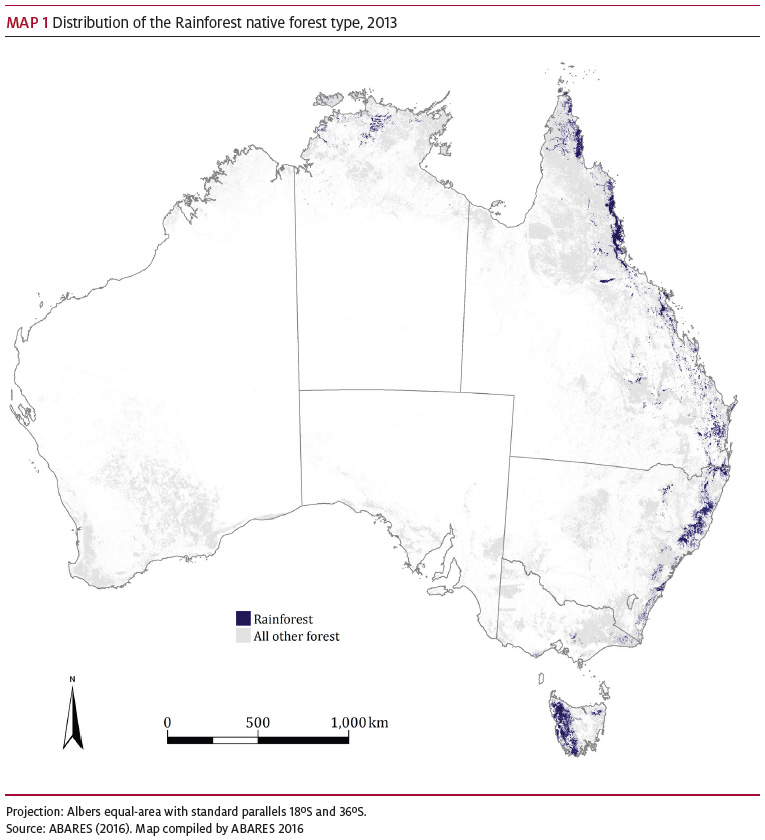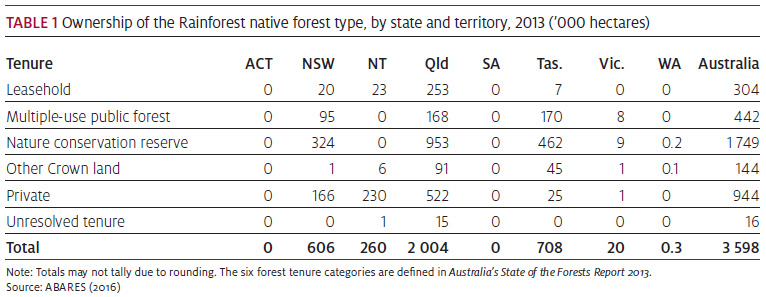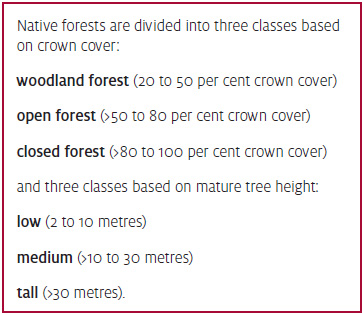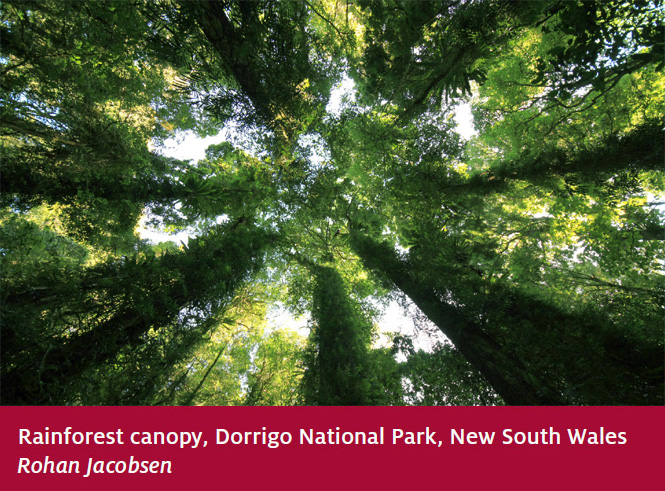This profile has been superseded by the 2019 version, which is available here.
View the complete Australian forest profiles series.
Information for this profile is drawn from Australia's State of the Forests Report 2013.
Australia has 3.6 million hectares of the Rainforest native forest type, which is 3 per cent of Australia’s total native forest area.
Australia’s rainforests are typically characterised by high rainfall, lush growth and closed canopies. They rarely experience fire, and generally contain no eucalypts or only the occasional individual eucalypt tree emerging from the rainforest canopy. Rainforest tree species are shade-tolerant when young and establish in the understorey of mature forest. They grow into large trees when events such as tree falls, lightning strikes or wind damage (including from cyclones) create gaps in the canopy.
Rainforests support a significant part of Australia’s biodiversity, including many of Australia’s unique plant families. The tropical rainforests in Far North Queensland are rich in marsupial, frog and butterfly species, while the cool-temperate rainforests of Tasmania support diverse fungi, mosses and lichens.
Distribution and ownership
The Rainforest native forest type is found in the Northern Territory and all states except South Australia (Map 1). Two million hectares (55 per cent) are in Queensland and 0.7 million hectares (20 per cent) are in Tasmania.

Open a high-resolution version of Map 1 that can be saved as a PNG file
Australia has many types of rainforest, varying with rainfall and latitude. Tropical and subtropical rainforests are found in northern and eastern Australia in wet coastal areas. Warm-temperate rainforests grow in New South Wales and Victoria, and cool-temperate rainforests are found in Victoria and Tasmania and in small areas at high altitude in New South Wales and Queensland. Dry rainforests occur in pockets protected from frequent fire in sub-coastal and inland areas of northern and eastern Australia and northern Western Australia. Monsoon rainforests occur in northern Australia in seasonally dry coastal and sub-coastal regions.
A total of 1.7 million hectares (49 per cent) of the Rainforest native forest type is on nature conservation reserves (Table 1).

Download Table 1 data as an Excel workbook
Large areas of rainforest are found in well-known national parks such as the Daintree National Park in northern Queensland, Barrington Tops National Park in the Hunter region of New South Wales and the Cradle Mountain-Lake St Clair National Park in Tasmania. A total of 0.9 million hectares (26 per cent) of the Rainforest forest type is on private land.
Forest structure
The Rainforest native forest type has a high proportion of closed forest at 72 per cent (2.6 million hectares) (Figure 1). Seventy-three per cent (2.6 million hectares) is medium-height forest.


Importance and uses
Rainforests are very important for the conservation of biodiversity. They provide habitat for many forest-dwelling and forest-dependent species of plants and animals. This includes numerous species that are endemic to Australia, and species listed as threatened under the Commonwealth Environment Protection and Biodiversity Conservation Act 1999.
Rainforest comprises only 3 per cent of Australia’s total native forest, but provides habitat for 60 per cent of Australia’s plant species, 60 per cent of butterfly species, 40 per cent of bird species and 35 per cent of mammal species.
Thirty-two per cent of Australia’s rainforests are within UNESCO World Heritage Areas. They are places of exceptional natural beauty and aesthetic importance. Both their rich biodiversity and their World Heritage Area status are strong drivers of tourism, ecotourism and associated economic benefits.
Bibliography
ABARES 2016, Forests of Australia (2013) v2.0, Australian Bureau of Agricultural and Resource Economics and Sciences.
Boland, D, Brooker, M, Chippendale, G, Hall, N, Hyland, B, Johnston, R, Kleinig, D, McDonald, M & Turner, J 2006, Forest trees of Australia, 5th edn, CSIRO Publishing, Melbourne.
Carnahan, JA 1990, Atlas of Australian resources, vol. 6, Vegetation, Australian Government Publishing Service, Canberra.
Montreal Process Implementation Group for Australia & National Forest Inventory Steering Committee 2013, Australia’s State of the Forests Report 2013, Australian Bureau of Agricultural and Resource Economics and Sciences, Canberra.

